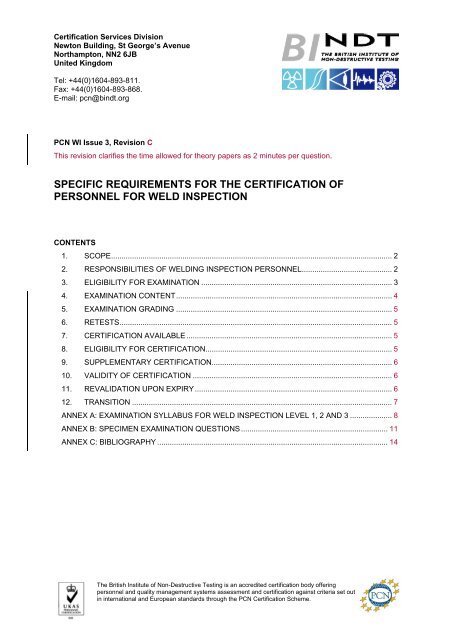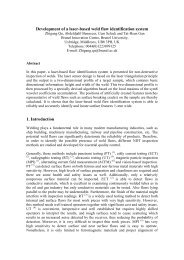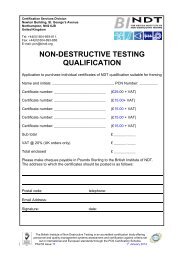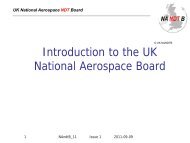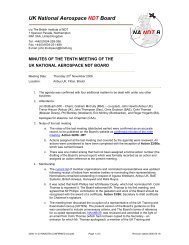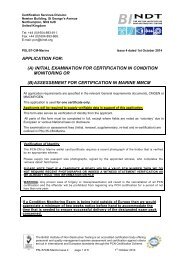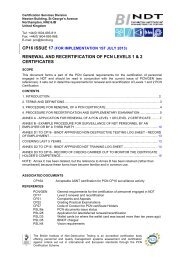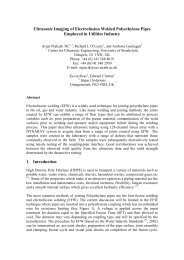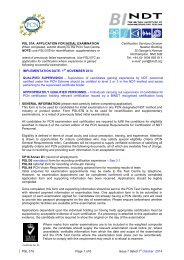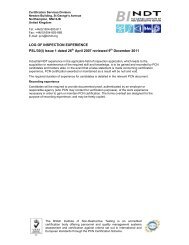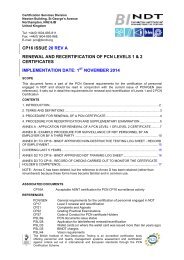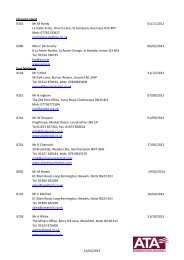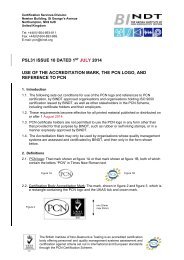PCN WI - BINDT
PCN WI - BINDT
PCN WI - BINDT
Create successful ePaper yourself
Turn your PDF publications into a flip-book with our unique Google optimized e-Paper software.
Certification Services DivisionNewton Building, St George’s AvenueNorthampton, NN2 6JBUnited KingdomTel: +44(0)1604-893-811.Fax: +44(0)1604-893-868.E-mail: pcn@bindt.org<strong>PCN</strong> <strong>WI</strong> Issue 3, Revision CThis revision clarifies the time allowed for theory papers as 2 minutes per question.SPECIFIC REQUIREMENTS FOR THE CERTIFICATION OFPERSONNEL FOR WELD INSPECTIONCONTENTS1. SCOPE ...................................................................................................................................... 22. RESPONSIBILITIES OF WELDING INSPECTION PERSONNEL ........................................... 23. ELIGIBILITY FOR EXAMINATION ........................................................................................... 34. EXAMINATION CONTENT ....................................................................................................... 45. EXAMINATION GRADING ....................................................................................................... 56. RETESTS .................................................................................................................................. 57. CERTIFICATION AVAILABLE .................................................................................................. 58. ELIGIBILITY FOR CERTIFICATION ......................................................................................... 59. SUPPLEMENTARY CERTIFICATION...................................................................................... 610. VALIDITY OF CERTIFICATION ............................................................................................... 611. REVALIDATION UPON EXPIRY .............................................................................................. 612. TRANSITION ............................................................................................................................ 7ANNEX A: EXAMINATION SYLLABUS FOR WELD INSPECTION LEVEL 1, 2 AND 3 .................... 8ANNEX B: SPECIMEN EXAMINATION QUESTIONS ...................................................................... 11ANNEX C: BIBLIOGRAPHY .............................................................................................................. 14The British Institute of Non-Destructive Testing is an accredited certification body offeringpersonnel and quality management systems assessment and certification against criteria set outin international and European standards through the <strong>PCN</strong> Certification Scheme.
1. SCOPE1.1. This document prescribes the specific requirements and procedures by which personnel maybe examined and, if successful, certificated for Weld Inspection at three levels (Level 1,Level 2 and Level 3 see paragraph 1.3). It includes requirements for certification,examination syllabus, specimen examination questions, and a bibliography.1.2. It is intended, through publication of these documents, to provide <strong>PCN</strong> candidates andcertificate holders with all relevant information. However, if further information or advice isrequired on any certification matter, please contact the Certification Services Division of<strong>BINDT</strong> on telephone number +44 (01604) 893811, or email questions to pcn@bindt.org.1.3. Copies of <strong>PCN</strong> documents are available free of charge from <strong>BINDT</strong> Certification ServicesDivision at Newton Building, St. Georges Avenue, Northampton NN2 6JB, United Kingdom.Organisations requiring at all times to be in possession of the most up to date <strong>PCN</strong>documents may register with the "<strong>PCN</strong> Update Scheme" which, for a small annual fee,guarantees that they automatically receive all new or revised <strong>PCN</strong> documents.2. RESPONSIBILITIES OF WELDING INSPECTION PERSONNEL2.1 The Weld Inspection Level 1 individual will:2.1.1 Have a basic understanding of welding techniques, welding positions, weldingconsumables, weld preparation and welding drawing requirements.2.1.2 Be able to use welding inspection gauges and other commonly used measuringdevices to check pre-weld fit ups and post-weld profiles.2.1.3 Be able to visually inspect welded constructions and correctly identify anyweld/welding imperfection present2.1.4 Understand the need for specifications, codes and standards and the need foracceptance levels.2.1.5 Verify that joint preparation and fit-up are in accordance with welding procedurespecifications and/or work instructions.2.1.6 Basic examination and evaluation of weld sequence.2.1.7 Visual inspection of completed welds.2.2 The Weld Inspection level 2 individual will:2.2.1 Understand and discharge all of the responsibilities for Weld Inspection level 12.2.2 Understand the detailed requirements of relevant codes, standards and specifications;2.2.3 Possess an understanding of the relationship between quality assurance, qualitycontrol and inspection procedures;2.2.4 Confirm that welders have been properly qualified in accordance with applicablecodes and standards, and that their certification is current and valid for the weldingprocedures applied;2.2.5 Observe the preparation of test pieces and destructive tests, verifying compliance withrelevant specifications;2.2.6 Verify against specifications the correctness of base/parent material and weldingconsumables;2.2.7 Verify that joint preparation and fit-up are in accordance with specifications;2.2.8 Confirm during welding that only specified and accepted welding procedures(approved by the appropriate quality, technical or regulatory authority) are used andapplied;2.2.9 Examine and evaluate welds according to the prescribed inspection procedures andacceptance levels;<strong>PCN</strong> <strong>WI</strong> issue 3 Rev C 2 of 15 1 st July 2014
2.2.10 Review NDT reports on welding work for which the Weld Inspection level 2 isresponsible;2.2.11 Record welding inspection results in a manner such that the welds inspected maysubsequently be identified.2.3 The Weld Inspection Level 3 individual will:2.3.1 Understand and discharge all of the responsibilities for Weld Inspection level 2;2.3.2 Plan, organize and implement a system of quality control over the welding andinspection process;2.3.3 Supervise Weld Inspection Level 1 and Weld Inspection level 2 personnel;2.3.4 Confirm that welding equipment used for the work is in good order and is appropriateto the process specified in the welding procedure, such that the desired weld qualitycan be achieved;2.3.5 Possess an understanding of the factors influencing the formation of weld defects andtheir acceptability in relation to codes, specifications and standards;2.3.6 Interpret weld drawings and specifications, having a thorough understanding of weldsymbols;2.3.7 Interpret weld radiographs;2.3.8 Assess NDT reports on welds, ensuring that NDT personnel are properly qualified andthat certification is relevant and valid for the testing performed;2.3.9 Physically examine the finished work for conformance to the applicable codes,standards, specifications and drawings;2.3.10 Compile and maintain detailed weld inspection records;2.3.11 Provide details related to the release of a Certificate of Conformity of welded productinspected.3. ELIGIBILITY FOR EXAMINATION3.1 Weld Inspection Level 1 candidates will have successfully completed a <strong>BINDT</strong>recognised course of training for Level 1 Weld Inspectors. (12 hours minimumduration)3.2 Weld Inspection level 2 candidates will have successfully completed a <strong>BINDT</strong>recognised course of training* for Weld Inspectors. (40 hours minimum duration)3.3 Weld Inspection Level 3 candidates will have successfully completed a <strong>BINDT</strong>recognised course of training* for Weld Inspection Level 3. (40 hours minimumduration)* Candidates with at least 5 years documented experience without significantinterruption in the discipline for which certification is sought, who can provide evidenceof completion of a course of training (covering the published <strong>PCN</strong> syllabus), need nothave attended a <strong>BINDT</strong> recognised course of training. Such candidates should applyto the <strong>BINDT</strong> Authorised Qualifying Body under the ‘mature candidate’ route. If asignificant interruption in continuity in carrying out welding inspection exists, thecandidate will be required to undertake further training determined by <strong>BINDT</strong>.3.4 All candidates and holders of <strong>PCN</strong> certification shall have satisfactory vision, asdetermined annually by an ophthalmologist, optometrist or medically recognizedperson. <strong>PCN</strong> document PSL/44 provides more information on the required visionstandard.<strong>PCN</strong> <strong>WI</strong> issue 3 Rev C 3 of 15 1 st July 2014
4. EXAMINATION CONTENT4.1 Weld Inspection Level 14.1.1 The theoretical examination is designed to assess candidate knowledge andunderstanding of the syllabus. The theoretical examination comprises onesection:4.1.1.1 30 multiple choice questions on basic welding theory, weld inspectionand product technology. Time allowed 60 minutes.4.1.2 The practical examination is designed to test the practical competence of thecandidate and comprises of:4.1.2.1 Assessment of welds for specific weld profile, weld imperfections andwelding process requirements. The sample range will include a filletweld and/or a tack welded joint and a completed butt weld. Timeallowed 2 hours.4.2 Weld Inspection level 24.2.1 The written examination is designed to assess the candidate’s knowledge andunderstanding of the syllabus. The written examination part comprises twosections:4.2.1.1 30 questions on general welding theory, welding inspection andproduct technology. Time allowed: 60 minutes.4.2.1.2 4 narrative questions selected by the candidate from 6 provided,covering specific welding technology. Time allowed: 1½ hours.4.2.2 The practical examination is designed to test the practical competence of thecandidate and comprises three parts:4.2.2.1 inspection of two macros, and/or a bend and fractured fillet for awelder or procedure approval test against BS EN ISO 5817: Timeallowed: 45 minutes4.2.2.2 inspection of a plate butt weld and reporting to a code provided by theexaminer. Time allowed: 1¼ hours.4.2.2.3 inspection of a pipe butt weld and reporting to a code nominated bythe candidate (which requires the prior approval of the examiner).Time allowed: 1¾ hours.4.3 Weld Inspection Level 34.3.1 Candidates not holding valid <strong>BINDT</strong> recognised Weld Inspector certificationwill be required to successfully complete the Weld Inspection Level 2examination prior to attempting the examination for Weld Inspection Level 3.4.3.2 The written examination part comprises:4.3.2.1 4 narrative questions selected by the candidate from 6 provided,covering specific welding technology. Time allowed: 1½ hours.4.3.2.2 20 multiple-choice answer questions on radiographic theory andinterpretation. Time allowed: 40 minutes.4.3.3 The practical examination part comprises four parts :4.3.3.1 Scrutinise and comment on three inspection related documents. Timeallowed: 1 hour.4.3.3.2 Inspection of two separate weld failures associated with defectsproducing a report on the proforma provided. Time allowed: 1 hour.4.3.3.3 Understanding of welding fabrication drawing symbols. Time allowed:1 hour.4.3.3.4 Interpretation of six radiographs of welds. The welds will have beenproduced by MMA, MIG, TIG, mechanised fusion and oxy-acetylene<strong>PCN</strong> <strong>WI</strong> issue 3 Rev C 4 of 15 1 st July 2014
welding (unless the candidate is a holder of a valid <strong>PCN</strong> certificatecovering radiographic interpretation of welds). This examination partwill include a requirement to comment on radiographic density andsensitivity. Time allowed: 1½ hours.5. EXAMINATION GRADINGTo be successful, candidates are required to achieve a grade of 70% in all relevant examination parts.6. RETESTSThe conditions for retest of failed examinations are given in document entitled <strong>PCN</strong> Inspection andTesting (General).7. CERTIFICATION AVAILABLE7.1 The following certification is available:7.1.1 Weld Inspection Level 17.1.2 Weld Inspection Level 27.1.3 Weld Inspection Level 38. ELIGIBILITY FOR CERTIFICATION8.1 Level 1 candidates will have successfully completed a <strong>PCN</strong> examination for WeldInspection Level 1 and:8.1.1 had a minimum of one month experience under supervision acceptable to<strong>BINDT</strong> in the syllabus areas given in section 2.18.2 Level 2 candidates will have successfully completed a <strong>PCN</strong> examination for WeldingInspection Level 2 for ferritic steel, and:8.2.1 have a minimum of twelve months experience under qualified supervisionacceptable to <strong>BINDT</strong> as a Weld Inspection Level 2 (certificated oruncertificated) carrying out the work activities listed in 2.1, or8.2.2 have held certification, acceptable to <strong>BINDT</strong>, covering non-destructive testingof welds for at least 12 months and have a minimum of six months experienceunder qualified supervision acceptable to <strong>BINDT</strong> as a certificated oruncertificated Weld Inspector Level 2 carrying out the work activities listed in2.1, or8.2.3 provide verifiable evidence of having been a welding instructor or weldingforeman/supervisor for a minimum of 12 months and have a minimum of sixmonths experience under qualified supervision acceptable to <strong>BINDT</strong> as acertificated or uncertificated Weld Inspector Level 2 carrying out the workactivities listed in 2.1.8.3 Level 3 candidates will have successfully completed a <strong>PCN</strong> examination for WeldInspection Level 3 and:8.3.1 have held <strong>BINDT</strong> recognised Weld Inspector Level 2 certification for at leasttwo years, or8.3.2 provide verifiable evidence of having typical job responsibilities of a WeldInspection Level 3 for at least five years.<strong>PCN</strong> <strong>WI</strong> issue 3 Rev C 5 of 15 1 st July 2014
9. SUPPLEMENTARY CERTIFICATION9.1 Holders of valid Weld inspection level 2 or Weld Inspection Level 3 certification mayapply for supplementary certification covering one or more of each of the followingmaterials groups:9.1.1 Aluminium and its alloys (MIG and TIG welding), and magnesium and itsalloys (TIG welding).9.1.2 Austenitic steels and high nickel alloys (MMA, MIG, TIG and mechanisedfusion welding), and Titanium alloys (inert gas welding).9.1.3 Copper (and its alloys) and Monel (MMA, MIG and TIG welding).9.2 Candidates for Weld Inspection Level 2 and/or Weld Inspection Level 3 of materialsdetailed above have first to gain certification for inspection of welds in ferritic steel.9.3 The written examination for all candidates will comprise 10 multiple choice answerquestions related to the materials technology for each of the materials groups in whichcertification is sought. Time allowed: 3 minutes per question.9.4 For Weld Inspection Level 3, success in a practical examination will be required. Thiswill consist of interpretation and comment on 4 weld radiographs for each materialgroup appropriate to the scope of the supplementary certification sought (unless thecandidate is a holder of a relevant valid <strong>PCN</strong> certificate covering radiographicinterpretation of that group of materials). The time allowed is 15 minutes perradiograph.10. VALIDITY OF CERTIFICATION10.1 The period of validity of the certification is described in <strong>PCN</strong> document I&T (GEN) :General Requirements for the Certification of Personnel for Engineering Inspectionand Testing.11. REVALIDATION UPON EXPIRY11.1 StatusCertificates have a status of either issue 01 or issue 02. Certificates bearing 01 areissued following success in an initial, supplementary or recertification examination.Certificates bearing 02 are issued following renewal after a review of satisfactoryevidence of continuity in the work for which they are issued.11.2 RenewalFor information on renewal, see <strong>PCN</strong> document I&T (GEN): General Requirements forthe Certification of Personnel for Engineering Inspection and Testing.11.3 RecertificationAll issue 02 certificates are revalidated through success in a recertificationexamination comprising:11.3.1 Weld Inspector Level 1 - All the practical elements given in section 4.1.2.1.11.3.2 Weld Inspector Levels 2 - A multiple choice answer written paper coveringthose elements of the syllabus relevant to scope of the certificate and apractical visual inspection and reporting on one weld.11.3.3 Weld Inspector Level 3 - A multiple choice answer written paper coveringthose elements of the syllabus relevant to scope of the certificate and apractical visual inspection and reporting on one weld.Weld Inspection Level 3 certificate holders will, in addition to the above, berequired to interpret and report on a total of six radiographs relevant to thescope of the certification unless the candidate is a holder of a valid <strong>PCN</strong>certificate covering radiographic interpretation of welds.<strong>PCN</strong> <strong>WI</strong> issue 3 Rev C 6 of 15 1 st July 2014
12. TRANSITION12.1 Holders of current valid weld inspection certification issued by other certificationbodies (recognised by <strong>BINDT</strong>) seeking to gain <strong>PCN</strong> certification for Weld Inspection atan equivalent level will be required to be successful in the <strong>PCN</strong> recertificationexamination.12.2 Holders of current valid weld inspection certification issued by other certificationbodies (recognised by <strong>BINDT</strong>) seeking to gain <strong>PCN</strong> certification for Weld Inspection ata higher level will be required to be successful in the <strong>PCN</strong> initial examination for thelevel of certification sought.<strong>PCN</strong> <strong>WI</strong> issue 3 Rev C 7 of 15 1 st July 2014
ANNEX A: EXAMINATION SYLLABUS FOR WELD INSPECTION LEVEL 1, 2 AND 3WELD INSPECTION LEVEL 1Will have an elementary understanding of the following syllabus sections:A1. The role of the Weld Inspector Level 1a) Specific duties and responsibilitiesb) Basic use of welding inspection equipmentc) Knowledge of welding related standards and specificationsA2. Weld terminologya) Types of jointb) Types of weldc) Types of joint preparationd) Weld zone termse) Weld positionsf) Welding processesA3. Welding proceduresa) The essential features of a welding procedureb) Welder approvalsc) Welding processes: a basic understanding of recognizingi) Oxy-gas weldingii) Manual metal arc (MMA) weldingiii) Metal inert gas (MIG) and metal active gas (MAG) weldingiv) Tungsten inert gas (TIG) weldingv) Plasma arc weldingvi) Submerged arc weldingA4. A basic understanding of recognizing thermal cuttinga) Flame cuttingb) Electric arc cuttingA5. Materialsa) Inspection pointsb) Size (thicknesses, lengths and diameters)c) Types (grade; composition against specifications)d) Cleanliness and surface condition for weldingA6. Weld imperfectionsa) Terminologyb) Weld imperfectionsc) Correct identification of weld imperfectionsd) Classification and significance of imperfectionse) Imperfections acceptance levelsf) Stress and distortionA7 Welding consumables IdentificationA8 Arc welding safetyg) Statutory health and safety requirement and practicesh) Protection againsti) Heat and lightii) Electric shockiii) Fumes and gasesWELD INSPECTION LEVEL 2 & 3The complexity of the examination for Weld Inspection Level 3 will require a greater in-depthunderstanding of the subjects listed.A9. The role of the Weld Inspector Level 2a) Specific dutiesb) Welding inspection equipmentA10. The role of the Weld Inspection Level 3a) Supervision of Weld inspector Level 2b) Auditingc) Record keeping<strong>PCN</strong> <strong>WI</strong> issue 3 Rev C 8 of 15 1 st July 2014
A11. Weld terminologya) Types of jointb) Types of weldc) Types of joint preparationd) Weld zone termse) Weld positionsA12. Welding proceduresa) The essential features of a procedureb) Welder approvals and their controlc) Welding processesi) Oxy-gas weldingii) Manual metal arc (MMA) Weldingiii) Metal inert gas (MIG) and metal active gas (MAG) weldingiv) Tungsten inert gas (TIG) weldingv) Plasma arc weldingvi) Submerged arc weldingA13. Thermal cuttinga) Flame cuttingb) Electric arc cuttingA14. Gouging processesA15. Materialsa) Inspection pointsb) Size (thicknesses, lengths and diameters)c) Types (grade; composition against specifications)d) Cleanliness and surface condition for weldingA16. Steel weldabilitya) Steelb) Grain structuresc) Heat affected zone (HAZ)d) The effect of hydrogen in steele) The carbon equivalent of steelf) Preheat, its application and controlg) Interpass temperatureA17. Weldability of steelsa) Steel types and their weldabilityb) Guidelines for the welding of steelA18. Stress and distortionA19. Post heat treatmenta) Stress relievingb) Annealingc) Normalisingd) Hardening/quenchinge) Temperingf) Hydrogen releaseA20. Welding procedures and welder testsA21. Visual examination and dimensional checking before and after weldingA22. Mechanical testing of welded jointsa) Tensile testb) Bend testc) Nick-break testd) Fillet weld fracture teste) Impact testf) Hardness testg) Macroscopic (macro) examinationh) Microscopic examinationi) Crack tip opening displacement testA23. Weld defects and repairsa) Terminologyb) Weld imperfections as stated in level 1c) Avoiding weld defectsd) Classification and significance of defectse) Defect acceptance levels<strong>PCN</strong> <strong>WI</strong> issue 3 Rev C 9 of 15 1 st July 2014
f) Repair weldingA24. Crackinga) Weld process cracksb) Service induced failuresc) Weld decay in austenitic stainless steelA25. Welding consumablesa) Filler rods and wiresb) MMA consumables (electrodes)c) Fusible insertsA26. Welding planta) Power sourcesb) Wire feedersc) Welding heads, guns and torchesd) Control unitse) Mechanised, automatic and robotic weldingA27. Symbols for weldinga) Standardsb) Elementary symbolsc) Supplementary symbolsd) Positions for symbolse) Dimensionsf) Complimentary indicationsA28. Arc welding safetya) Statutory health and safety requirement and practicesb) Protection againsti) Heat and lightii) Electric shockiii) Fumes and gasesA29. Welding related specifications and standardsA30. Weld drawings, understanding and interpretationA31. Reportinga) Welding inspection reportsb) NDT report assessmentA32. Quality assurancea) The aims, benefits and scope of QAb) Comparisons of QA, quality control and inspectionc) QA standardsA33. Certificationa) Weldersb) Weld Inspector Level 2c) NDT personnelA34. Normative documents (codes)A35. Non-Destructive Testing (NDT)a) Penetrant Testing (PT)b) Magnetic Particle Testing (MT)c) Radiographic Testing (RT)i) Interpretation of weld radiographs (syllabus contained in <strong>PCN</strong>/GEN appendix C2.2)ii) Radiation safety (syllabus contained in <strong>PCN</strong>/GEN appendix E3.2)d) Ultrasonic Testing (UT)e) Eddy Current Testing (ET)f) Visual Testing (VT)<strong>PCN</strong> <strong>WI</strong> issue 3 Rev C 10 of 15 1 st July 2014
ANNEX B: SPECIMEN EXAMINATION QUESTIONSMULTI-CHOICE QUESTIONS FOR WELD INSPECTION LEVEL 11) It is the duty of a Level 1 weld inspector to:a) choose the welding process.b) choose the welding technique.c) follow the guidelines given by Level 2 and 3 weld inspectors.d) Any of the above if given permission by <strong>PCN</strong>.2) Which of the following usually has the most influence on imperfection types?a) Weld process.b) Weld position.c) Parent material.d) Poor welding skills.3) What instrument could be used to measure the cap height on a plate butt weld?a) An X-ray setb) An ultrasonic set with a 0° probe.c) A weld inspection gauge.d) There is no need to measure the cap height.4) The distance between the root and the face of a fillet weld is known as:a) Mitre sizeb) Throat thicknessc) Leg lengthd) Face widthMULTI-CHOICE QUESTIONS FOR WELD INSPECTION LEVEL 21) Voltage, amperage, travel speed and pre-heat temperature are all variables which will affect :a) Post weld heat treatmentb) Carbon contentc) Heat inputd) Melting temperature2) The contour of welds forming notches at the weld toes can affect which of the following?a) Fatigueb) Grain structurec) Low temperature propertiesd) Both A and C3) Weld metal can essentially be considered as a:a) unique itemb) small castingc) upset forgingd) none of the above4) Annealing can be used to achieve which of the following aims?a) To soften the steelb) To relieve internal stresses caused by some previous treatmentc) To release hydrogen which may have become trapped in the HAZd) Any of the above5) The Vickers Hardness Machine uses:a) a diamond square based pyramidb) a steel ball 1.58 mm in diameterc) a hardened steel ball 10 mm in diameterd) a fulcrum and jockey weight<strong>PCN</strong> <strong>WI</strong> issue 3 Rev C 11 of 15 1 st July 2014
6) Which of the following NDT methods would be best able to locate lack of sidewall fusion in asingle vee plate weld 25 mm thick at a depth of 5-7 mm?a) Magnetic particle testingb) Penetrant testingc) Ultrasonic testingd) Eddy current testingNARRATIVE QUESTIONS FOR WELD INSPECTION LEVEL 21) Describe the duties of a Weld Inspector Level 2 . References to your chosen specification areexpected in your answer (open book).2) State which mechanical tests are required for a 914mm (36”) diameter MMA pipe butt weld usingyour chosen procedure for the qualification of a welding procedure specification (WPS)qualification test. Describe the number of tests and the location of test pieces taken from the testsample. (openbook)3) Explain the probable causes of tungsten inclusions in a TIG weld and what precautions can betake to prevent them.4) Describe four reasons for the use of pre-heat. State the criteria which determine the pre-heattemperature.MULTI-CHOICE RADIOGRAPHIC QUESTIONS FOR WELD INSPECTION LEVEL 31) Collimators should be selected:a) by the quality control manager only.b) for gamma ray sources only.c) based on the film speed used.d) to be of the size and shape to limit the beam only to the area of interest.2) Which of the following will cause artefacts on radiographs?a) Cracked lead screens.b) Static electricity.c) Pressure after exposure.d) All of the above.3) What is the one requirement that every radiographic film base must have?a) Flexibility.b) Transparency.c) Toughness.d) Fine grain.4) A film being manually processed was tapped gently to remove bubbles but streakiness stilloccurred. This is because:a) developer was spilled on the film prior to development.b) developer contaminated the fixer.c) the film was not agitated sufficiently during development.d) water splashed on the film prior to development.5) Thin sheets of lead foil in intimate contact with radiographic film increase film density becausethey:a) fluoresce and emit visible light which helps expose the film.b) absorb the scattered radiation.c) prevent back-scattered radiation from fogging the film.d) emit electrons which helps darken the film.6) An IQI is used to determine the:a) size of a discontinuity in the part.b) density of the film.c) radiographic contrast.d) quality of the radiographic image.<strong>PCN</strong> <strong>WI</strong> issue 3 Rev C 12 of 15 1 st July 2014
NARRATIVE QUESTIONS FOR WELD INSPECTION LEVEL 31) As the Senior Welding Inspector you are required to visit a site where your Welding Inspectorsand NDT Inspectors have been working. What questions would you ask them and whichdocuments would you check as a “Final Documentation Review” before submission to the client?2) Which NDT method would you expect to be used to accurately locate and size lack of sidewallfusion in a submerged arc carbon steel weld? Discuss the reasons for your choice of method overother possible NDT methods and give the advantages and disadvantages of your chosen method.3) Explain how hydrogen induced cold cracking occurs in carbon steel welds and discuss methods ofprevention.4) A centerline crack has been detects during NDT inspection of a carbon steel weld. Give thepossible reasons for its formation and discuss methods of prevention.<strong>PCN</strong> <strong>WI</strong> issue 3 Rev C 13 of 15 1 st July 2014
ANNEX C: BIBLIOGRAPHYESSENTIAL READING: CODES AND STANDARDS FOR WELD INSPECTION EXAMINATIONSThe candidate (or employer) has to choose a code or specification for use in the examination. This isused in two examination modules, the narrative question relating to Weld Inspector Level 2 duties andthe practical pipe sample. Below is a list of possible codes and standards that can be used in theexamination, this is not an exhaustive list and an examiner at the AQB will be able to advise on thesuitability of any proposed alternatives. A clean unmarked copy of the standard is required for theexamination, also if the standard is not on the list below a copy needs to be sent with the application toverify its suitability. It is the responsibility of the candidate to ensure they are in possession of theapplicable and most up to date code or specification.Transco T/SP/P2BS 4515-1: Specification for process of welding of steel pipelines on land and offshoreAPI STD 1104 Welding of Pipelines and Related FacilitiesPD 5500 Specification for unfired fusion welded pressure vesselsBS EN 1011 Welding recommendations. (In conjunction with BS EN ISO 5817 Arc Welded Joints inSteel, guidance on quality levels for imperfections).BS 4677: Specification for arc welding of austenitic stainless steel pipe work for carrying fluidsBS 2633: Specification for class 1 arc welding of ferritic steel pipe work for carrying fluidsBS 2971: Specification for class II arc welding of carbon steel pipe work for carrying fluidsASME VIII: Boiler & Pressure Vessel Code VIIIANSI B31.3 : Chemical Plant and Petroleum Refinery PipingAWS D1.1 Structural steel welding codeOTHER STANDARDSGeneralBS 499, Part 1: Welding terms and symbols. Glossary for welding, brazing and thermal cutting.BS EN 4063: Nomenclature of processes and reference numbersBS EN 22553: Welded, brazed and soldered joints-symbolic representation on drawings.Qualification of welders and proceduresBS EN 287, Part 1: Approval testing of welders for fusion welding - Steels.BS EN ISO 9606-2: Qualification test of welders. Fusion welding Aluminium and aluminium alloys.BS EN ISO 15614-1: Specification and qualification of welding procedures for metallic materials.Welding procedure testArc and gas welding of steels and arc welding of nickel and nickel alloysBS EN ISO 15614-2: Specification and qualification of welding procedures for metallic materials.Welding procedure testArc welding of aluminium and its alloys.ASME IX: Welding and brazing qualifications.Welding consumablesBS EN ISO 2560: Welding consumables. Covered electrodes for manual metal arc welding of nonalloyand fine grain steels. Classification.BS EN ISO 636: Welding Consumables. Rods, wires and deposits for tungsten inert gas welding ofnon-alloy and fine-grain steels. Classification.BS EN ISO 18275: Welding Consumables. Covered electrodes for manual metal arc welding of highstrengthsteels. Classification.BS EN ISO 17632: Welding Consumables. Tubular cored electrodes for gas shielded and non-gasshielded metal arc welding of non-alloy and fine grain steels. Classification.<strong>PCN</strong> <strong>WI</strong> issue 3 Rev C 14 of 15 1 st July 2014
AWS A 5.1: Specification for covered carbon steel welding electrodes.Quality assurance & quality controlBS EN ISO 17637: Non-destructive testing of welds. Visual testing of fusion-welded joints.BS EN ISO 3452-1: Non-destructive testing. Penetrant testing. General principles.BS EN ISO 17638: Non-destructive testing of welds. Magnetic Particle testing.BS EN ISO 17636-2: Non-destructive testing of welds: Radiographic testing X- and gamma-raytechniques with digital detectors.BS EN ISO 19232-1: Non-destructive testing. Image Quality of Radiographs, Determination of theimage quality value using wire-type image quality indicators.BS EN ISO 19232-2: Non-destructive testing. Image Quality of Radiographs, Determination of theimage quality value using step/hole-type image quality indicators.BS EN 1321: Macroscopic and microscopic examination of weldsBS EN ISO 5173: Destructive tests on welds in metallic materials - Bend testsBS EN ISO 5817: Arc Welded Joints in Steel, guidance on quality levels for imperfections.BS EN ISO 9000: 2000 Quality Management Systems - Fundamentals and VocabularyBS EN ISO 9001: Quality Management Systems.- RequirementsBS EN 729/ISO 3834: Quality requirements for welding.BS EN ISO 9712: NDT and Certification/Qualification of NDT personnelThis is not an exhaustive list and local/national standards in many parts of the world will cover similartopics.TRAINING MATERIALTraining Course Notes.<strong>BINDT</strong> requires candidates to have attended a recognised course of training. Training Establishmentsare required to provide trainees with an up-to-date set of training course notes. These are consideredessential reading.RECOMMENDED READINGProduct Technology Classroom Training Handbook. <strong>BINDT</strong>/<strong>PCN</strong> Publication, NewtonBuilding, St. Georges Avenue, Northampton, NN2 6JB.<strong>PCN</strong> Classroom Training Handbook on the Visual Non-Destructive Testing of MetallicMaterials in General Engineering use. <strong>BINDT</strong>/<strong>PCN</strong> Publication, Newton Building, St. GeorgesAvenue, Northampton, NN2 6JB.Welders Handbook; A Complete Guide to Mig, Tig, Arc and Oxyacetylene Welding. RichardFinch, HP Books, ISBN 1557882649 Practical Welding. S W Gibbon, Macmillan Educational Ltd, ISBN 0333609573The Science and Practice of Welding Vol. 1, Welding Science and Technology. A C Davies,Cambridge University Press, ISBN 052143565XThe Science and Practice of Welding Vol. 2, The Practice of Welding. A C Davies, CambridgeUniversity Press, ISBN 0521435668Weld Symbols on Drawings. Welding Institute, Woodhead Publishing, ISBN 085300157X Welding Principles and Applications. Larry F Jeffus, Delmar Publishers ISBN 0827382405 Metallurgy of Basic Weld Metal. G Evans, William Andrews Inc., ISBN 1855732432Handbook of Structural Welding, Processes, Materials and Methods used in the Welding ofMajor Structures, Pipelines and Process Plants. John Lancaster, Woodhead Publishing, ISBN1855733439<strong>PCN</strong> <strong>WI</strong> issue 3 Rev C 15 of 15 1 st July 2014


